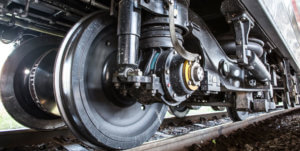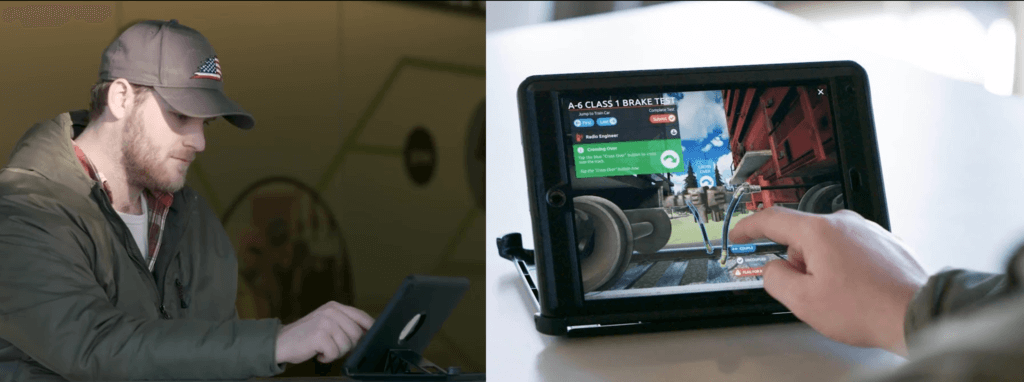 The nation’s rail industry moves 24/7, 365 days per year and in all kinds of weather. Nothing stops it – not even global pandemics.
The nation’s rail industry moves 24/7, 365 days per year and in all kinds of weather. Nothing stops it – not even global pandemics.
But that doesn’t mean it chugs along unchanged. Far from it. It means there are necessary – and sometimes significant – shifts that need to take place as it continues forward though.
“Digital is no longer a Strategy – but a Necessity”
The biggest shift spanning every industry including railroading, is an accelerated digital transformation. As a result, Virtual, Digital and Asynchronous training tools are becoming a necessary part of railroad’s new normal. Let’s see how that looks.
Shifting Priorities, But Always Moving
According to AAR’s CEO, Ian Jefferies, rail traffic has seen a 20% reduction from last year, but things have begun to turn around. There has been a gradual climb toward a more robust situation, with railroads adjusting based on when and where freight, passengers and commuters need to be moved. Railroaders have adapted and changed for 150 years though, so this is hardly cause for alarm.
Recent years have seen lots of changes, after all. Increasing need for intermodal operations, with containers full of consumer goods passed from ship to train to truck is one example. This mode of transportation makes sense, as one train can move 100-120 truckloads of goods, so it’s good financially and ecologically. This option also decreases traffic congestion and emissions, while supporting a sustainable future. It’s a win-win.
And then technological changes have happened as well, helping railroads innovate as they expand and transition operations. Sensors and detectors have become ubiquitous, allowing railway workers to listen to and inspect trains and tracks, ensuring that railroading’s stellar industry-wide safety record remains intact. “The best it’s been in the history of the industry,” Jeffries shared.
And now, it’s time for another change – a pivotal one, as we see that innovative technological focus turn toward training – simulation training.
Safety & Training Protocols for 4th and 5th Generation Railroaders
As an industry with 4th and 5th generation workers spanning a variety of different work crafts, careers in railroading is a way of life. It’s one of few industries where you’ll find such a strong sense of loyalty to a vocation. And that feeling is mutual, with railroads committed to worker success and safety.
So, with revised protocols across the U.S. affecting every form of human interaction, this new normal can be found on railroads as well. Much like other industries, railways are taking precautionary measures to protect workers’ health and well-being, including:
- Restricting access to mission-critical locations like operations and dispatching centers to only essential staff who must be present to perform their duties and restricting vendor presence on railroad property.
- Expanding social distancing by limiting movement around the network by individual employees and activating secondary dispatch and operation locations.
- Transitioning employees to telework where possible to reduce density, including those not directly involved in train operations and at headquarters.
- Instituting new measures to limit spread by restricting domestic and international employee air travel, selectively allowing personal vehicle use and coordinating with suppliers and vendors to ensure they are also taking proper protections.
A key distinction, and advantage, here is that this workforce is used to strict guidelines as a matter of course. And an adherence to safety protocols is really nothing new, though the protocols themselves have changed.
But therein lies the challenge: How to train workers not only on shifting requirements, but keep them current with existing procedures as well, in an environment where ‘in-person’ anythings are restricted. Some of these social distancing requirements are likely here to stay, and railroads will need to add pandemic planning to their preventative measures moving forward. So, having ongoing, simulation training protocols in place just makes sense.
The Association of American Railroads (AAR) is busy laying the groundwork for these revised standards, as referenced above – and as AAR’s CEO, Ian Jefferies recently shared. As in-person options become less viable, virtual simulation training efforts have accelerated in kind, offering the perfect fit to keep this “always on” industry moving forward, on schedule.
Simulation Training in Railroading
With subject matter experts’ access to specific worksites restricted as the potential for partial lockdowns looms for the next 18-24 months, railroads are seeking workarounds. Every industry is preparing for future pandemics by building redundancies into their operations and supply chains. And these initiatives will take years to develop and optimize.
Fortunately for railroading, there are a growing number of templated simulations and guides already in place, thanks to timely efforts made by BNSF, Norfolk Southern and CSX in partnership with Heartwood. Existing simulation trainings span Brake Test (CFR 232) (with a corresponding FRA Part 243 training requirements waiver), a Pre-departure Inspection (CFR 215), a Locomotive Daily Inspection (CFR 229), and corresponding virtual interactive guides for each.
These portable, lightweight interactive simulations and guides facilitate repeated practice and mastery of important requirements and safety protocols. Railroad employees learn visually and self-assess to attain and demonstrate proficiency by practicing virtually – anytime, anywhere. Railroads can evaluate their employees’ skills before they go onto the field, offering remediation around any incorrect knowledge in advance. The ROI here is exceptional. And beyond having proficiently trained railroaders, saving money is always a welcome idea!
These ‘workarounds’ offer immersive, collaborative options that closely replicate critical maintenance, safety and compliance tasks. And the railroads implementing them are extremely pleased.
This is good news for everyone, as simulation training is no longer a strategy, but a necessity. Reach out to discuss your railroad’s unique needs.



